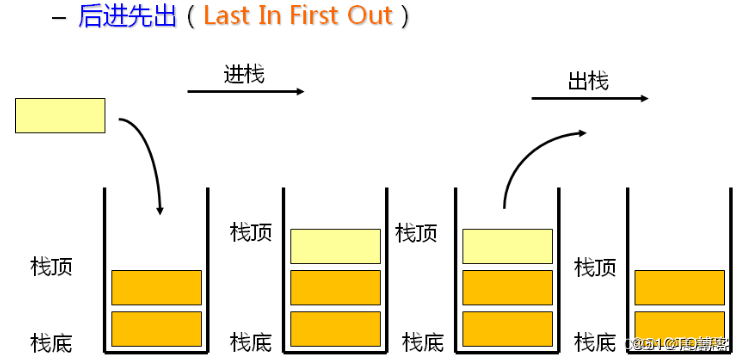目錄
棧的概念及其結構
棧的實現
數組棧
鏈式棧
?棧的常見接口實現
主函數Test.c
頭文件&函數聲明Stack.h
頭文件
函數聲明
函數實現Stack.c
初始化SLInit
擴容Createcapacity
壓棧STPush
出棧STPop
棧頂元素STTop
判斷棧是否為空STempty
棧內元素個數STSzie
數組棧空間釋放STDestroy
數組棧總代碼?
我們已經學習過了【線性表】中的順序表和鏈表。今天開始進入棧和隊列。棧和隊列是順序表和鏈表的延續,也是一種線性表(線性表在邏輯上也是連續的)。大體結構上都很相似,所以大家學習起來也會很容易的。但是棧和隊列也有自己獨特的性質,學習也需要特別注意哦。
棧的概念及其結構
棧:一種特殊的線性表,其只允許在固定的一端進行插入和刪除元素操作。進行數據插入和刪除操作的一端稱為棧頂,另一端稱為棧底。
棧中的數據元素遵守 后進先出 / 后進先出 LIFO(Last In First Out)的原則
壓棧:棧的插入操作叫做進棧/壓棧/入棧,入數據在棧頂。
出棧:棧的刪除操作叫做出棧。出數據也在棧頂。?

?
【先進后出/后進先出】可以類比【彈夾】

棧的實現
了解了棧的概念,如何實現棧呢?
根據前面博文我們可以【數組棧】和【鏈式棧】?
數組棧
數組棧比較簡單,也是快速容易實現,首先就是【數組棧】實現。

鏈式棧
鏈式棧分為【單鏈表】和【雙向鏈表】去實現棧。毋庸置疑,【雙向鏈表實現】棧頂可以是尾巴,也可以是頭,因為雙向鏈表的頭插/頭刪和尾插/尾刪都是很方便的。
但是為了節省資源,我們用【單鏈表】該怎樣去設計呢?
單鏈表實現棧:棧頂只能是單鏈表頭(頭插/頭刪易),棧底只能是單鏈表尾(頭刪很復雜)
 ?
?
?棧的常見接口實現
- 斷言NULL/Pop==0情況
- 改變結構體用指針
- top的指向
- 單個數據直接用,多個數據用結構體包含起來
- 數組的數據訪問用數組下標即可訪問
- pst和pst->a搞清楚!
- 入棧順序是只有一種,但是出棧順序有多種!!
主函數Test.c
#include"Stack.h"
int main()
{ST pst;//創建結構體STInit(&pst);//傳地址是修改結構體內部STPush(&pst, 1);STPush(&pst, 2);STPush(&pst, 3);STPush(&pst, 4);STPush(&pst, 5);while (!STempty(&pst)){printf("%d ", STTop(&pst));STPop(&pst);}STDestroy(&pst);
}由于棧是其只允許在固定的一端進行插入和刪除元素操作。所以棧的訪問是必須先Pop彈出元素才能訪問下一個元素。
while (!STempty(&pst)){printf("%d ", STTop(&pst));STPop(&pst);}頭文件&函數聲明Stack.h
頭文件
#pragma once
#include<stdio.h>
#include<assert.h>
#include<stdlib.h>
#include<stdbool.h>函數聲明
- 創建結構體
typedef int STDatatype;
typedef struct Stack
{STDatatype* a;int top;int capacity;
}ST;- 初始化
void STInit(ST* pst);- 釋放銷毀
void STDestroy(ST* pst);- 壓棧
void STPush(ST* pst, STDatatype x);- 出棧
void STPop(ST* pst);- 棧頂元素
STDatatype STTop(ST* pst);- 判斷棧是否為NULL
bool STempty(ST* pst);- 棧內的元素個數?
int STSize(ST* pst);函數實現Stack.c
初始化SLInit
?如果初始化 top=0:表示棧內元素的個數。作為a[top]指針指向棧頂元素的下一個。
?如果初始化 top=-1:表示數組元素的下標。作為a[top]指針指向棧頂元素。?
#include"Stack.h"
void STInit(ST* pst)
{assert(pst);pst->a = 0;
//表示top指向棧頂元素的下一個位置pst->top = 0;
//表示top指向棧頂元素//pst->top = -1;pst->capacity = 0;
}擴容Createcapacity
void Createcapacity(ST* pst)
{//擴容if (pst->top == pst->capacity){int newcapacity = pst->capacity == 0 ? 4 : 2 * pst->capacity;ST* tmp = (ST*)realloc(pst->a, sizeof(ST) * newcapacity);if (tmp == NULL){perror("realloc fail");return;}pst->a = tmp;pst->capacity = newcapacity;}
}壓棧STPush
void STPush(ST* pst, STDatatype x)
{assert(pst);Createcapacity(pst);pst->a[pst->top] = x;pst->top++;
}出棧STPop
void STPop(ST* pst)
{assert(pst);assert(pst->top > 0);pst->top--;
}棧頂元素STTop
STDatatype STTop(ST* pst)
{assert(pst);assert(pst->top > 0);return pst->a[pst->top-1];
}判斷棧是否為空STempty
bool STempty(ST* pst)
{assert(pst);return pst->top == 0;//為0就是true 為!=0就是為flase
}棧內元素個數STSzie
int STSize(ST* pst)
{assert(pst);return pst->top;
}數組棧空間釋放STDestroy
void STDestroy(ST* pst)
{assert(pst);free(pst->a);pst->a = NULL;pst->top = 0;pst->capacity = 0;
}數組棧總代碼?
//Test.c
#include"Stack.h"
int main()
{ST pst;STInit(&pst);STPush(&pst, 1);STPush(&pst, 2);STPush(&pst, 3);STPush(&pst, 4);STPush(&pst, 5);while (!STempty(&pst)){printf("%d ", STTop(&pst));STPop(&pst);}STDestroy(&pst);
}
//Stack.h
#pragma once
#include<stdio.h>
#include<assert.h>
#include<stdlib.h>
#include<stdbool.h>typedef int STDatatype;
typedef struct Stack
{STDatatype* a;int top;int capacity;
}ST;void STInit(ST* pst);
void STDestroy(ST* pst);
void STPush(ST* pst, STDatatype x);
void STPop(ST* pst);
STDatatype STTop(ST* pst);
bool STempty(ST* pst);
int STSize(ST* pst);
//Stack.c
#include"Stack.h"
void STInit(ST* pst)
{assert(pst);pst->a = 0;pst->top = 0;pst->capacity = 0;
}void Createcapacity(ST* pst)
{//擴容if (pst->top == pst->capacity){int newcapacity = pst->capacity == 0 ? 4 : 2 * pst->capacity;ST* tmp = (ST*)realloc(pst->a, sizeof(ST) * newcapacity);if (tmp == NULL){perror("realloc fail");return;}pst->a = tmp;pst->capacity = newcapacity;}
}void STPush(ST* pst, STDatatype x)
{assert(pst);Createcapacity(pst);pst->a[pst->top] = x;pst->top++;
}void STPop(ST* pst)
{assert(pst);assert(pst->top > 0);pst->top--;
}STDatatype STTop(ST* pst)
{assert(pst);assert(pst->top > 0);return pst->a[pst->top-1];
}bool STempty(ST* pst)
{assert(pst);return pst->top == 0;//為0就是true 為!=0就是為flase
}int STSize(ST* pst)
{assert(pst);return pst->top;
}void STDestroy(ST* pst)
{assert(pst);free(pst->a);pst->a = NULL;pst->top = 0;pst->capacity = 0;
}
?????最后,感謝大家的閱讀,若有錯誤和不足,歡迎指正!各位小伙伴乖乖敲代碼哦。?
代碼---------→【唐棣棣 (TSQXG) - Gitee.com】
聯系---------→【郵箱:2784139418@qq.com】








![FileNotFoundError: [Errno 2] No such file or directory: ‘patchelf‘: ‘patchelf‘](http://pic.xiahunao.cn/FileNotFoundError: [Errno 2] No such file or directory: ‘patchelf‘: ‘patchelf‘)






)
多線程并發庫)


)
